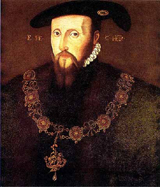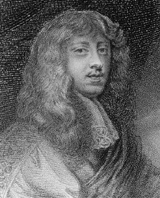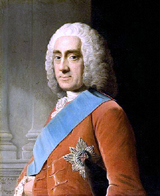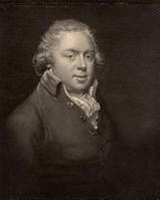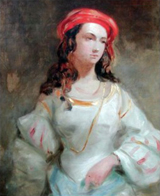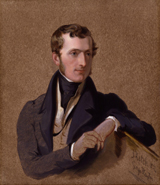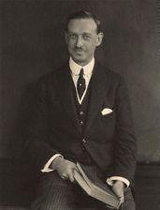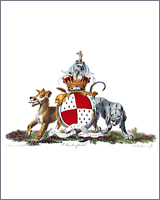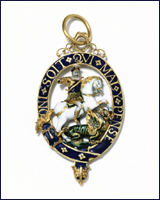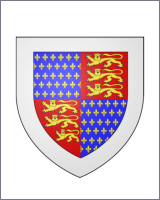Stanhope…
Edward Stanhope (c. 1469-1511)
Sir Edward Stanhope [m. Avelina Clifford | Elizabeth Bourchier], son of Sir Thomas Stanhope and Mary Jerningham. Sir Edward Stanhope was the father, by his first wife, Avelina Clifford, to Sir Michael Stanhope (c. 1494-1552), executed in 1552 on Tower Hill, London and, by his second wife, Elizabeth Bourchier, to Anne Seymour (nee Stanhope), the Duchess of Somerset (c. 1497-1587).
Edward fought in the Battle of Stoke in 1487, as commander of the Royal army. He fought in the Battle of Blackheath in 1497, was Knighted by Henry VII (1457–1509) the same year.
Before Edward
The date of Edwards death is uncertain, is found recorded on the Internet as: 1511 and 6 June 1512. He descended from Sir Thomas Stanhope [d. before 1493]. Before Sir Thomas: John Stanhope (d. 1493) and Elizabeth Talbot, Sheriff of Nottinghamshire and Derbyshire, and Member of Parliament for Nottinghamshire between 1450 and 1472; Richard Stanhope (d. 1432) [m. Adela or Elizabeth Markham | Maud de Deincourt (uncertain)]; John Stanhope | Sir Richard Stanhope (1377-1436) [m. Elizabeth Staveley | Matilda Maud Cromwell or de Cromwell], Knighted in 1399; Sir John Stanhope (d.c. 1380) [m. Elizabeth Malovell or Maulovel | Elizabeth Cuyly or Culley]; Richard Stanhope (d. 1379).
Data within this document may require some clarification, if you can help please complete the online form.
Richard Stanhope (1492-1527)
Richard Stanhope [m. Anne Strelley], eldest son of Sir Edward Stanhope (c. 1469-1511), had only one daughter and heir Saunchia (b. 1513), who married John Babington (Derbyshire). It's understood that she inherited the estate of Rampton, and that Rampton Manor passed to the Babington family, having been in the Stanhope dynasty spanning some 150 or so years from 1374 through 1531.
The Manor is thought to have been kept in the Babington family for generations, however conflicting findings suggest that it may have been sold to Sir William Holles, merchant and lord mayor of London, while it is also said that it was passed to Anthony Eyre second husband of John (descendant of Saunchia and John) Babington's widow [unk.], and remains with the Eyre family.
Part of Tuxford which descended with Rampton to Saunchia is said to have been sold to John White esq, grandfather of Sir John White who reportedly purchased much of the remaining land.
Coincidently, Sir William Holles was the great grandfather of John Holles, 1st Earl of Clare (1564-1637), an English nobleman. The Earl, John Holles, married Anne Stanhope, daughter to Sir Thomas Stanhope (eldest son of Sir Michael, executed on Tower Hill, 1552).
Data within this document may require some clarification, if you can help please complete the online form.
Michael Stanhope (c. 1494-1552)
Michael Stanhope [m. Anne Rawson] was the youngest son, his mother being Avelina, daughter of Sir Gervase Clifton. His elder brother Richard (1492-1527) married Anne, daughter and co-heir of John Strelley of Strelley. Michael's half-sister Anne Stanhope (c.1497-1587) Countess of Hertford, married Edward Seymour, Duke of Somerset, and Lord Protector of England, temp. Edward VI. Michael was appointed Governor of Hull, Knighted by Henry VIII, and made chief gentleman of the Privy Chamber to King Edward VI.
Michael had acquired former monastic lands including Elvaston at the time of the Dissolution of the Monasteries. In June 1536 the Crown granted the priory to Sir Michael for 60 years at a rental of £20. He built Shelford Manor on the site, and when he died in 1552, the estate was said to have been passed to his son Sir Thomas Stanhope.
Estates are thought to have been divided between Sir Michael's great grandsons, Philip (created Earl of Chesterfield in 1628) who inherited Shelford in Nottinghamshire and Bretby in Derbyshire, and John who inherited Elvaston which remained a family seat until the mid 20th century.
Sir Michael had naturally benefited by his close relationship to so powerful and influential a nobleman as his brother-in-law, the Lord Protector, but the conspiracy that caused the latter's downfall and subsequent execution also involved him, for he was imprisoned in 1551, and shortly afterwards (25th February, 1552) shared the same fate as his relative on Tower Hill.
He had been implicated in the events that led to the downfall of his brother-in-law Edward Seymour, and was beheaded in 1552 alongside Sir Thomas Arundell who was earlier Knighted at the coronation of Anne Boleyn (d. 1536) in 1533. Anne Boleyn had become Henry VIII's second queen consort (following Katharine of Aragon (1485-1536), mother to Queen Mary I (1516-1558)), but was also to die at the Tower of London on 19 May 1536.King Henry VIII (1491-1547)
Henry VIII [m. Katharine of Aragon (1485-1536), first queen consort = Queen Mary I (1516-1558) | Anne Boleyn (d. 1536), second queen consort = Queen Elizabeth I (1533-1603) | Jane Seymour (1508-1537), third queen consort = Edward VI (1537-1553) | Anne of Cleves (1515-1557), forth queen consort | Katharine or Catherine Howard (d. 1542), fifth queen consort | Katharine Parr(e) or Catherine Parr (1512-1548), last queen consort, sixth wife of Henry VIII].Anne Stanhope (c. 1497-1587)
Anne Stanhope [m. Edward Seymour] was the daughter of Sir Edward Stanhope (c. 1469-1511) and Elizabeth Bourchier, also half-sister to Richard and Sir Michael. As the wife of Edward Seymour, Duke of Somerset who held the office of Lord Protector during the first part of the reign of his nephew King Edward VI, Anne, Duchess of Somerset, was briefly the most powerful woman in England, claiming precedence over the Dowager Queen Katharine Parr(e).
Anne, through her mother, was a direct descendant of Thomas of Woodstock, 1st Duke of Gloucester (1355-1397), the youngest son of King Edward III of England (1312-1377) and Queen Philippa of Hainault (1314-1369).Edward Seymour (c. 1506-1552)
Edward Seymour [m. Catharine Fillol | Anne Stanhope] (1st Duke of Somerset), was uncle to Edward VI (1537-1553), and Lord Protector of England (1547-1549) in the period between the death of Henry VIII (1491-1547), in 1547 and his own indictment in 1549. Edward was born in about 1506 to Sir John Seymour and Margery Wentworth, a celebrated beauty immortalised in the works of John Skelton. Edward's first marriage, to Catharine Fillol, was annulled when it was discovered she was having an affair with his father. His second marriage was to Anne Stanhope (d. 1587).
Edward was the eldest brother of Jane Seymour (1508-1537), who would become Henry VIII's third queen consort (following Anne Boleyn mother to Queen Elizabeth I (1533-1603)), and mother to Edward VI. When Jane married the King in 1536, Edward was created Viscount Beauchamp on 5 June, and on 15 October 1537 Earl of Hertford. He became Warden of the Scottish Marches and continued in favour after his sister's death in 1537.
Their brother Thomas, also gained power through their sister's advancement, married Henry VIII's sixth wife, Dowager Queen Katharine Parr(e), shortly after the death of the King. Seymour's nephew became Edward VI on the death of Henry VIII. Edward Seymour retained great influence over the boy king, Edward VI, in whose name he ruled the country, and was created 1st Duke of Somerset on 15 February 1547, early on in King Edward's reign.
Following his victory over the Scots at the Battle of Pinkie Cleugh, the Duke's position appeared unassailable. However, the Seymour brothers had accumulated enemies and grudges during their time in royal favour and, shortly after his brother Thomas's downfall in 1548, Edward too fell from power. His position, although not his office of Protector, was taken by John Dudley, 1st Earl of Warwick and later 1st Duke of Northumberland…
…His properties (such as Somerset House, Sleaford Castle and Berry Pomeroy Castle) were confiscated by the crown, and he was executed for treason on Tower Hill on 22 January 1552.Lady Jane Grey (c. 1537-1554)
During the latter part of Edward VI's reign, Lady Jane Grey, eldest daughter of Henry Grey, Marquess of Dorset, was empowered by her father-in-law John Dudley (1504-1553), 1st Duke of Northumberland and Lord Protector of England (1549-1553), following the death of Edward VI in 1553.
Lady Jane was to briefly reside at the Tower of London (during the shortest reign in English history), but was herself later executed because of her father-in-law John Dudley's part in a bid to displace the rightful heir to the throne, Edward VI's elder half-sister, Queen Mary I. It had been John Dudley that Edward Seymour and Sir Michael Stanhope were accused of attempting to overthrow, leading to their earlier execution at the Tower of London in 1552.
John Dudley's was sentenced and put to death for high treason for his part in the Wyatt's Rebellion, for his endeavour to displace Edward's sister Mary with his own daughter-in-law, Lady Jane Grey.
The Wyatt's Rebellion was a popular uprising in England following the death of King Edward VI, named after Thomas Wyatt the younger, one of its leaders. The rebellion was intended to overthrow the newly crowned Queen.Thomas Stanhope (1540-1596)
Sir Thomas [m. Margaret Port] was the son of Sir Michael Stanhope and Ann Rawson. He was 12 years old when his father was executed in 1552. He lived at Shelford Manor Nottinghamshire, became Member of Parliament for Nottinghamshire, Tudor England. He reportedly died in debt, thought partly due to the cost of rebuilding Shelford Manor, which had been passed to him following his father's death on Tower Hill.
Thomas had a number of siblings including; Sir Edward (1 (1543-1603)), John, 1st Baron Stanhope of Harrington (c. 1545-1621), Dr Sir Edward (2 (1547-1608)), and Sir Michael (1549-1621) [m. Anne Read(e)].John Stanhope (c. 1545-1621)
John Stanhope, 1st Baron Stanhope of Harrington was an English courtier, politician and peer. The third son of Sir Michael Stanhope, after Jane, he was born in Yorkshire, but brought up in Nottinghamshire after his father was held for treason in 1552. Sir John Stanhope was himself Knighted in 1596, and his peerage passed to his son, Charles in 1621.
Data within this document may require some clarification, if you can help please complete the online form.
John Stanhope (1559-1611)
Sir John Stanhope [m. Cordell Allington | Catherine Trentham] was an English knight and landowner. He was the son of Sir Thomas Stanhope of Shelford Manor in Nottinghamshire, England and the father of the 1st Earl of Chesterfield.
The Stanhope's were staunch to the Royal cause and King Charles I (1600-1649). Sir Philip Stanhope was elevated to the Peerage as Baron Stanhope of Shelford in 1616, and further advanced to the Earldom of Chesterfield in 1628.James Stanhope (1673-1721)
James Stanhope was born in Paris, the eldest of the seven children of Alexander Stanhope (1638-1707), and his wife Katherine (d. 1718), the daughter and co-heir of Arnold Burghill…Philip Stanhope (1714-1786)
Philip Stanhope [m. Grizel Hamilton] (2nd Earl of Stanhope) was a British peer and a Fellow of the Royal Society. The son of the 1st Earl of Stanhope and Lucy Pitt, he succeeded to his father's titles in 1721. On 25 July 1745, he married the daughter of Charles Hamilton, Lord Binning. They had two sons, including his heir Charles Stanhope.Charles Stanhope (1753-1816)
Charles Stanhope (3rd Earl of Stanhope) was an British statesman and scientist. He was born in 1753 at London and died in 1816. Charles was the father of the great traveller and Arabist Lady Hester Stanhope and brother-in-law of William Pitt the Younger. He is sometimes confused with an exact contemporary of his, Charles Stanhope (1753-1829), the 3rd Earl of Harrington.
The son of the 2nd Earl of Stanhope, Charles was educated at Eton, and had an interest in science from an early age. While at the University of Geneva, he devoted himself to the study of mathematics under Georges-Lois Le Sage. He made numerous experiments regarding the application of steam to ships, invented a printing press - known as the Stanhope press, invented a microscopic lens and constructed calculating machines.
Politically he was revolutionary, opposed the slave trade, opposed the war against France, which earned for him the nickname 'Citizen Stanhope', and was a supporter of education and electoral and fiscal reforms. His lean and awkward figure was extensively caricatured by James Sayers and James Gillray, reflecting his political opinions and his relationship with his children.Hester Lucy Stanhope (1776-1839)
The Lady Hester Stanhope was an English eccentric. She was born in 1776 at Chevening, Kent and died in 1839. The eldest daughter of Charles Stanhope, the 3rd Earl of Stanhope and a niece of William Pitt the Younger (1759-1806). She went in 1803 to keep house for her uncle, William Pitt, over whom she acquired a remarkable ascendancy.
On his death in 1806 Lady Hester received a pension of £1200 a year, but was thought to have found life dull after the position she had held, so left England in 1810 with a small entourage, and by 1813 had settled at Mount Lebanon in Syria. There she lived out the rest of her life in a quasi Oriental style, surrounded by servants and exercising a sort of dominion over neighbouring tribes.Philip Henry Stanhope (1781-1855)
Philip Henry Stanhope (4th Earl of Stanhope) was an English aristocrat, chiefly remembered for his role in the Kaspar Hauser case during the 1830s. He sat in parliament for Wendover in 1806-1807, Hull in 1807-1812, and Midhurst from 1812 until his succession to the peerage on 15 December 1816. Sharing his father's (the 3rd Earl of Stanhope) scientific interest, he was elected to the Royal Society on 8 January 1807, and was a president of the Medico-Botanical Society. Philip was also a vice-president of the Society of Arts.
Like other members of his gifted family, notably his sister Lady Hester Stanhope, he is thought to have been a somewhat eccentric character. Having studied in Germany, he would travel in Europe, evidently consorting at various princely courts. In contrast to some accounts, which suggest that he may have lived beyond his means, it appears almost certain that he was a rich man, at least after he had succeeded his father in 1816.Philip Henry Stanhope (1805-1875)
Philip Henry Stanhope (5th Earl of Stanhope) was a British historian. He was born in 1805 and died in 1875. Educated at Christ Church, Oxford, he entered parliament in 1830. Until his succession to the title in 1855 he was styled Viscount Mahon, an unwavering opponent of the Reform Bill of 1832. In 1842 he was instrumental in amending the law of copyright. Among his historical works is the 'Life of William Pitt' published in 1862.Arthur Philip Stanhope (1838-1905)
Arthur Stanhope (6th Earl of Stanhope), was a British politician. From 1855 to 1875 he was styled Viscount Mahon. He sat as a Member of Parliament for Leominster in 1868 and Suffolk East 1870-1875. He was Lord Lieutenant of Kent from 1890 to 1905. He succeeded to the title of Earl of Stanhope on the death of his father 24 December 1875. He was succeeded by his son, James Richard Stanhope (13th Earl of Chesterfield).James Richard Stanhope (1880-1967)
James Stanhope [m. Eileen Browne] (7th Earl of Stanhope and 13th Earl of Chesterfield, KG, PC), was a British politician in the late 1930s as the Earl of Stanhope. He married Lady Eileen Browne (1889-1940), the eldest daughter of George Ulick Browne 6th Marquess of Sligo and Agatha Stewart Hodgson, granddaughter of William Forsyth QC.
In 1952 he succeeded his kinsman the 12th Earl of Chesterfield as 13th Earl of Chesterfield and 7th Baron Stanhope, but never used the more senior Earldom of Chesterfield, and continued to be known as the Earl of Stanhope. As he had no close heirs, both Earldoms and the Barony of Stanhope ended when he died, but the Viscountcy of Stanhope of Mahon and the Barony of Stanhope of Elvaston passed to his nearest heir, the 11th Earl of Harrington. James Stanhope left his country seat Chevening to the Nation.
